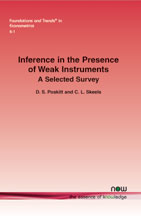Inference in the Presence of Weak Instruments: A Selected Survey
By D. S. Poskitt, Department of Econometrics and Business Statistics, Monash University, Australia, donald.poskitt@monash.edu | C. L. Skeels, Department of Economics, The University of Melbourne, Australia, Chris.Skeels@unimelb.edu.au
Abstract
Here we present a selected survey in which we attempt to break down the ever burgeoning literature on inference in the presence of weak instruments into issues of estimation, hypothesis testing and confidence interval construction. Within this literature a variety of different approaches have been adopted and one of the contributions of this survey is to examine some of the links between them. The vehicle that we will use to establish these links will be the small concentration results of Poskitt and Skeels (2007), which can be used to characterize various special cases when instruments are weak. We make no attempt to provide an exhaustive survey of all of the literature related to weak instruments. Contributions along these lines can be found in, inter alia, Stock et al. (2002), Dufour (2003), Hahn and Hausman (2003), and Andrews and Stock (2007), and we view this survey as complementary to those earlier works.
Inference in the Presence of Weak Instruments
Inference in the Presence of Weak Instruments is concerned with inference in the linear simultaneous equations model. The ideas developed for this model have remained central to econometric practice, with the use of instrumental variables estimation having served as a unifying paradigm in econometrics for decades. The literature could be viewed as belonging to one of two strands, either large-sample asymptotic or finite-sample analysis. Of these two strands, the former matured more quickly and has had far greater impact on empirical practice than the latter. In contrast, the finite-sample literature took some twenty years longer to develop, by which time empirical practice was largely entrenched. The consensus view was that the asymptotic results are considerably simpler to interpret than the exact results that are obtained, and are notionally more general as they are predicated on weaker distributional assumptions.
Towards the end of the 1980s, both strands of the literature focused attention on models that were either unidentified or close to unidentified. First, there was a growing understanding of the empirical consequences of using weak instruments. Second, the finite-sample results developed throughout the 1980s invariably involved multiple infinite series of invariant polynomials of matrix argument which were typically not very revealing. Consequently, simplifying special cases were explored to illustrate the results contained within the more general expressions. It was observed that the leading terms of these series expansions corresponded to totally unidentified models, and therefore the analyses of these models became a commonly used expository device in this literature. These totally unidentified models can be thought of as limiting cases of weak instruments. Finally, it was becoming clear that the existing large-sample asymptotic results were providing very poor approximations to the true sampling behavior of various statistical procedures. More recently, the literature has been devoted to analyzing potential remedies to the problem of weak instruments
Inference in the Presence of Weak Instruments presents a selected survey that examines this growing literature into issues of estimation, hypothesis testing, and confidence interval construction. This survey indicates some of the links between the different traditions by using the small concentration results from an earlier publication of the authors. These results can be used to characterize various special cases when instruments are weak.
